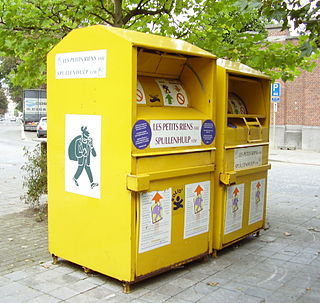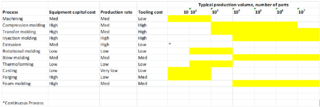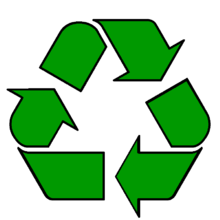
Recycling is the process of converting waste materials into new materials and objects. The recovery of energy from waste materials is often included in this concept. The recyclability of a material depends on its ability to reacquire the properties it had in its original state. It is an alternative to "conventional" waste disposal that can save material and help lower greenhouse gas emissions. It can also prevent the waste of potentially useful materials and reduce the consumption of fresh raw materials, reducing energy use, air pollution and water pollution.

Waste management or waste disposal includes the processes and actions required to manage waste from its inception to its final disposal. This includes the collection, transport, treatment and disposal of waste, together with monitoring and regulation of the waste management process and waste-related laws, technologies, economic mechanisms.

Zero waste is a set of principles focused on waste prevention that encourages redesigning resource life cycles so that all products are reused. The goal of this movement is to avoid sending trash to landfills, incinerators, or the ocean. Currently, only 9% of global plastic is recycled. In a zero waste system, the material will be reused until the optimum level of consumption is reached. The definition adopted by the Zero Waste International Alliance (ZWIA) is:
Zero Waste: The conservation of all resources by means of responsible production, consumption, reuse and, recovery of all products, packaging, and materials, without burning them and without discharges to land, water, or air that threaten the environment or human health.

Downcycling, or cascading, is the recycling of waste where the recycled material is of lower quality and functionality than the original material. Often, this is due to the accumulation of tramp elements in secondary metals, which may exclude the latter from high-quality applications. For example, steel scrap from end-of-life vehicles is often contaminated with copper from wires and tin from coating. This contaminated scrap yields a secondary steel that does not meet the specifications for automotive steel and therefore, it is mostly applied in the construction sector.

Material efficiency is a description or metric (Mp) which refers to decreasing the amount of a particular material needed to produce a specific product. Making a usable item out of thinner stock than a prior version increases the material efficiency of the manufacturing process. Material efficiency goes hand in hand with Green building and Energy conservation, as well as other ways of incorporating Renewable resources in the building process from start to finish.

Plastic recycling is the reprocessing of plastic waste into new products. When performed correctly, this can reduce dependence on landfill, conserve resources and protect the environment from plastic pollution and greenhouse gas emissions. Although recycling rates are increasing, they lag behind those of other recoverable materials, such as aluminium, glass and paper. Since the beginning of plastic production in the 20th century, until 2015, the world has produced some 6.3 billion tonnes of plastic waste, only 9% of which has been recycled, and only ~1% has been recycled more than once. Additionally, 12% was incinerated and the remaining 79% disposed of to landfill or to the environment including the sea.

Glass recycling is the processing of waste glass into usable products. Glass that is crushed or imploded and ready to be remelted is called cullet. There are two types of cullet: internal and external. Internal cullet is composed of defective products detected and rejected by a quality control process during the industrial process of glass manufacturing, transition phases of product changes and production offcuts. External cullet is waste glass that has been collected or reprocessed with the purpose of recycling. External cullet is classified as waste. The word "cullet", when used in the context of end-of-waste, will always refer to external cullet.

Reuse is the action or practice of using an item, whether for its original purpose or to fulfill a different function. It should be distinguished from recycling, which is the breaking down of used items to make raw materials for the manufacture of new products. Reuse – by taking, but not reprocessing, previously used items – helps save time, money, energy and resources. In broader economic terms, it can make quality products available to people and organizations with limited means, while generating jobs and business activity that contribute to the economy.

Waste diversion or landfill diversion is the process of diverting waste from landfills. The success of landfill diversion can be measured by comparison of the size of the landfill from one year to the next. If the landfill grows minimally or remains the same, then policies covering landfill diversion are successful. For example, currently in the United States there are 3000 landfills. A measure of the success of landfill diversion would be if that number remains the same or is reduced. In 2015 it was recorded that the national average of landfill diversion in the United States was 33.8%, while San Francisco had implemented the most effective policies and had recorded a landfill diversion rate of 77%.
Precycling is the practice of reducing waste by attempting to avoid buying items which will generate waste into home or business. The U.S. Environmental Protection Agency (EPA) also cites that precycling is the preferred method of integrated solid waste management because it cuts waste at its source and therefore trash is eliminated before it is created. According to the EPA, precycling is also characterized as a decision-making process on the behalf of the consumer because it involves making informed judgments regarding a product's waste implications. The implications that are taken into consideration by the consumer include: whether a product is reusable, durable, or repairable; made from renewable or non-renewable resources; over-packaged; and whether or not the container is reusable.

Textile recycling is the process of recovering fiber, yarn, or fabric and reprocessing the material into new, useful products. Textile waste is split into pre-consumer and post-consumer waste and is sorted into five different categories derived from a pyramid model. Textiles can be either reused or mechanically/chemically recycled.

Upcycling, also known as creative reuse, is the process of transforming by-products, waste materials, useless, or unwanted products into new materials or products perceived to be of greater quality, such as artistic value or environmental value.

Waste are unwanted or unusable materials. Waste is any substance discarded after primary use, or is worthless, defective and of no use. A by-product, by contrast is a joint product of relatively minor economic value. A waste product may become a by-product, joint product or resource through an invention that raises a waste product's value above zero.
Recycling can be carried out on various raw materials. Recycling is an important part of creating more sustainable economies, reducing the cost and environmental impact of raw materials. Not all materials are easily recycled, and processing recyclable into the correct waste stream requires considerable energy. Some particular manufactured goods are not easily separated, unless specially process therefore have unique product-based recycling processes.
Products made from a variety of materials can be recycled using a number of processes.

A circular economy is a model of production and consumption, which involves sharing, leasing, reusing, repairing, refurbishing and recycling existing materials and products as long as possible. CE aims to tackle global challenges as climate change, biodiversity loss, waste, and pollution by emphasizing the design-based implementation of the three base principles of the model. The three principles required for the transformation to a circular economy are: eliminating waste and pollution, circulating products and materials, and the regeneration of nature. CE is defined in contradistinction to the traditional linear economy. The idea and concepts of circular economy (CE) have been studied extensively in academia, business, and government over the past ten years. CE has been gaining popularity since it helps to minimize emissions and consumption of raw materials, open up new market prospects and principally, increase the sustainability of consumption and improve resource efficiency.
Resource recovery is using wastes as an input material to create valuable products as new outputs. The aim is to reduce the amount of waste generated, thereby reducing the need for landfill space, and optimising the values created from waste. Resource recovery delays the need to use raw materials in the manufacturing process. Materials found in municipal solid waste, construction and demolition waste, commercial waste and industrial wastes can be used to recover resources for the manufacturing of new materials and products. Plastic, paper, aluminium, glass and metal are examples of where value can be found in waste.

Cotton recycling is the process of converting cotton fabric into fibers that can be reused into other textile products.

The economics of plastics processing is determined by the type of process. Plastics can be processed with the following methods: machining, compression molding, transfer molding, injection molding, extrusion, rotational molding, blow molding, thermoforming, casting, forging, and foam molding. Processing methods are selected based on equipment cost, production rate, tooling cost, and build volume. High equipment and tooling cost methods are typically used for large production volumes whereas low - medium equipment cost and tooling cost methods are used for low production volumes. Compression molding, transfer molding, injection molding, forging, and foam molding have high equipment and tooling cost. Lower cost processes are machining, extruding, rotational molding, blow molding, thermoforming, and casting. A summary of each process and its cost is displayed in figure 1.

Closed Loop Box Reuse, is the process by which boxes or other other containers are reused many times. It is a form of reusable packaging.



















